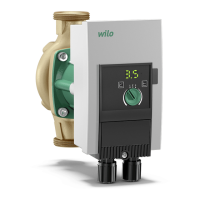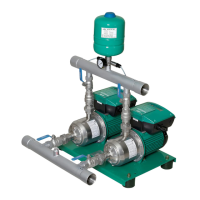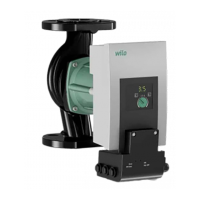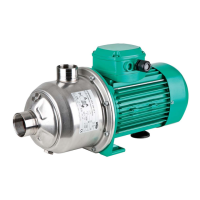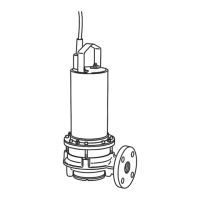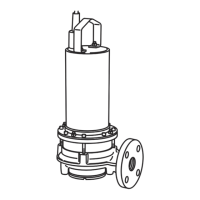Installation and electrical connection en
Installation and operating instructions Wilo-Medana CH1-L, Wilo-Medana CH3-LE 15
Install insulating material (cork or reinforced rubber) under the pump to avoid noise
pollution and vibrations being transmitted to the installation.
7.3 Mains connection
ƒ The weight of the piping should not be borne by the pump (Fig.5).
ƒ Permitted pump installation positions (Fig.9).
ƒ We recommend installing gate valves on the suction and pressure sides of the
pump.
ƒ Use expansion joints to mitigate noise and vibration from the pump if required.
ƒ The pipe cross-section must be at least equal to the diameter of the suction port
on the pump housing.
ƒ The installation of a non-return valve in the discharge pipe is recommended to
protect the pump against pressure surges.
ƒ If connected directly to the public potable water mains, the suction pipe socket
must also be fitted with a non-return valve and a stop valve.
ƒ If connected indirectly via a tank, the suction pipe socket must be fitted with a
suction strainer to stop impurities from entering the pump, and a non-return valve.
7.4 Electrical connection
DANGER
Risk of electrocution
In case of a non-compliant electrical connection, there is a risk of electrocution.
■ Have the electrical connection established by an electrician approved by the local
energy supply company in accordance with local regulations.
■ Prior to the electrical connection, the pump must be voltage-free and protected
against unauthorised restart.
■ To ensure safe installation and operation, the pump must be earthed correctly
with the earth terminals of the power supply (Fig.6).
ƒ Verify that the rated current, voltage and frequency used match the information on
the pump’s rating plate.
ƒ The pump must be connected to the power supply using a cable fitted with a
socket or a main switch.
ƒ The three-phase motors must be connected to an authorised protection system.
The setting rated current must match the value indicated on the motor’s sticker.
ƒ Single-phase motors are equipped as standard with thermal motor protection,
which stops the pump if the permissible winding temperature is exceeded and
starts it up again automatically once it has cooled down.
ƒ The connection cable must be placed in such a way that it never comes into con-
tact with the main sewer system and/or the pump housing and motor frame.
ƒ The pump/installation should be earthed in accordance with local regulations.
ƒ Appropriate measures for protection against insulation malfunctions must be
taken. For example, the use of a residual-current device. The breaking capacities of
the overcurrent protection devices must be greater than the assumed short-circuit
current at the devices.
ƒ The power supply connection must comply with the wiring diagram (Fig.6).
WARNING
Risk of injuries and water penetration in the connection area
Observe the tightening torques (Fig.7)
Observe the diameter value of the cable gland wiring to ensure IP55 protection (see
Fig.7[E]):
M20 = min. Ø6 – max. Ø12
M25 = min. Ø13 – max. Ø18
7.5 Operation with a frequency con-
verter
It is possible to adjust the speed of the pump using a frequency converter. The limit val-
ues for adjusting the speed are as follows:
40% rated ≤ n ≤ 100% rated. The installation and commissioning instructions for the
frequency converter must be followed when connecting it and starting operation. To
avoid overloading the motor winding, which could lead to damage and unwanted noise,
the frequency converter cannot produce voltage rise speed stages higher than 500V/μs
or voltage spikes U>650V.

